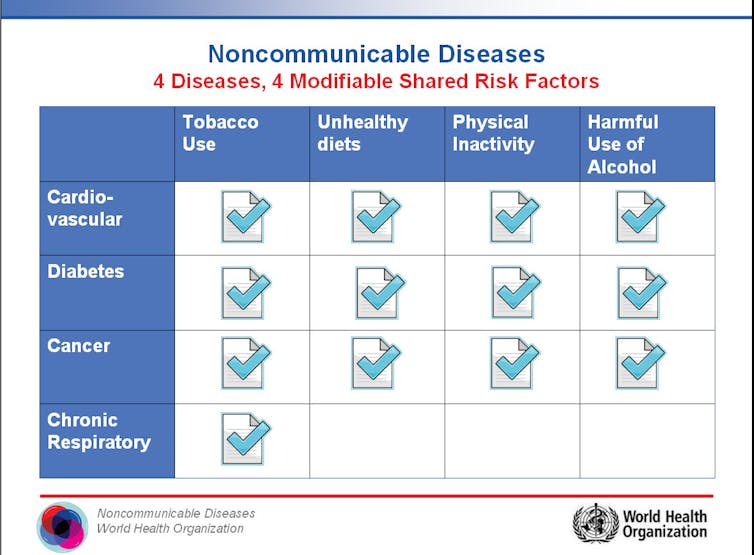Coming to the business end of a PhD on NCDs, I often get asked by colleagues and peers “what are Non-Communicable Diseases?”..
Let’s explore..

NCDs, or Non-Communicable Diseases, literally mean diseases one cannot catch from another person. Communicable means infectious, so it is a group of diseases defined by what they are not. Evolving from the remnants of the “traditional” diseases, which were largely infectious and those which posed the greatest burdens of disease for many centuries, ‘NCDs’ focus on new global threats.
So if they are all the diseases one cannot catch, NCDs include a wide range of ailments. This is in fact true: mental health to cancers, injuries to diabetes. In order to simplify things and in a bid to focus efforts, funding and solutions, the World Health Organization (WHO) defines NCDs as four diseases which combined, result in more deaths than any other cause. These diseases are diabetes, heart disease, cancers and chronic lung diseases.

I should take this opportunity to also explain that ‘chronic’, an alternative label given to NCDs (Chronic Disease) simply means diseases which affect a person over a long period, at least more than 3 months.
Diabetes, heart disease, cancers and chronic lung diseases.
At first glance, it is a little confusing to see why this group of diseases, which are diverse in nature, would be clustered together under this title. Sure, they cannot be caught from another person (although this is not actually 100% true), but they affect different organs, manifest diverse symptoms and have separate health effects..
In fact, this grouping makes a lot of sense.
The main four risk factors, the drivers of these diseases, are shared across all four ailments. They share causes and so they also share opportunities for prevention and mitigation. This is an esential point. Addressing tobacco consumption, unhealthy diets, insufficient exercise and alcohol misuse would go a long way to mitigating all four diseases.
Big bang, for each public health buck…
In fact, many argue that addressing these four risk factors would also make needed headway in addressing the direct and indirect health burdens posed by mental health - an all-to-often forgotten NCD.
So we know what these diseases are now, but why does it matter? Here are three good reasons…
NCDs are the leading cause of death worldwide, and in Australia, accounting for around 60% of all deaths globally in 2008.
Contrary to what you might think, 80% of these deaths occur in low, and middle-income countries. Not only because nations like China and India are home to a billion citizens each, but actually the age-standardised, prevalence rates are highest amongst the poorest nations. Even in nations like Australia, the UK and the USA, diseases such as diabetes and heart disease are associated with poverty and socio-economic deprivation.
The good news: 80% of diabetes and heart disease, and 1/3 of cancers are preventable with the tools, knowledge and strategies available today. Most of the medications to treat the vast majority of disease is relatively cheap and available, and in fact the most effective strategies for reducing the burden of NCDs actually lie outside the health system. Measures such as regulation of advertising, improving access to healthier foods, reducing exposures to tobacco smoke, addressing dietary salt consumption and encouraging physical activity are all great ways to combat this group of ailments.
So although just a snapshot, you now know what NCDs are, why it matters and what we can do about it…
Important not only because it’s an enormous health challenge affecting many of us, but also because it’s one we must all tackle together.
-
For more on global health and NCDs, explore Translational Global Health, from Alessandro and PLOS.
